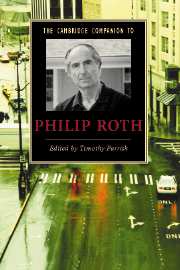Book contents
- Frontmatter
- Introduction: Roth at mid-career
- 1 American-Jewish identity in Roth’s short fiction
- 2 Roth, literary influence, and postmodernism
- 3 Zuckerman Bound: the celebrant of silence
- 4 Roth and the Holocaust
- 5 Roth and Israel
- 6 Roth’s doubles
- 7 Revisiting Roth’s psychoanalysts
- 8 Roth and gender
- 9 Roth and ethnic identity
- 10 Roth’s American Trilogy
- 11 Roth’s autobiographical writings
- Further reading
- Index
5 - Roth and Israel
Published online by Cambridge University Press: 28 May 2007
- Frontmatter
- Introduction: Roth at mid-career
- 1 American-Jewish identity in Roth’s short fiction
- 2 Roth, literary influence, and postmodernism
- 3 Zuckerman Bound: the celebrant of silence
- 4 Roth and the Holocaust
- 5 Roth and Israel
- 6 Roth’s doubles
- 7 Revisiting Roth’s psychoanalysts
- 8 Roth and gender
- 9 Roth and ethnic identity
- 10 Roth’s American Trilogy
- 11 Roth’s autobiographical writings
- Further reading
- Index
Summary
In The Anatomy Lesson (1983), Roth has his authorial alter ego, Nathan Zuckerman, explicitly blame the loss of his writerly subject on the creation of the Jewish state. In the wake of Israel, Zuckerman has exhausted the subject of being an American Jew. While “the great Jewish struggle was with the Arab states,” Zuckerman's own great struggle was with “the Jersey side of the Hudson, his West Bank.” His difficulty was to portray how this conflict had ended with his territory “occupied now by an alien tribe.” Zuckerman's despair is that with his parents dead and his neighborhood lost, he must confront the recognition that “no new Newark was going to spring up again for” him (Zuckerman Bound, 445).
One might well imagine that when Zuckerman does, in The Counterlife, recover his “posture for writing” -or perhaps his imposture for writing - it is because Israel has finally been launched into the position of “homeland” and, thereby, Oedipal father. “There's a world outside the Oedipal swamp,” Nathan's brother Henry angrily responds in The Counterlife, when Nathan questions Henry's new-found home in a right-wing Israeli settlement. “Tell me something, is it at all possible, at least outside of those books, for you to have a frame of reference slightly larger than the kitchen table in Newark?” (Counterlife, 138). Nathan's response amounts to an honest and resounding no.
- Type
- Chapter
- Information
- The Cambridge Companion to Philip Roth , pp. 68 - 81Publisher: Cambridge University PressPrint publication year: 2007



